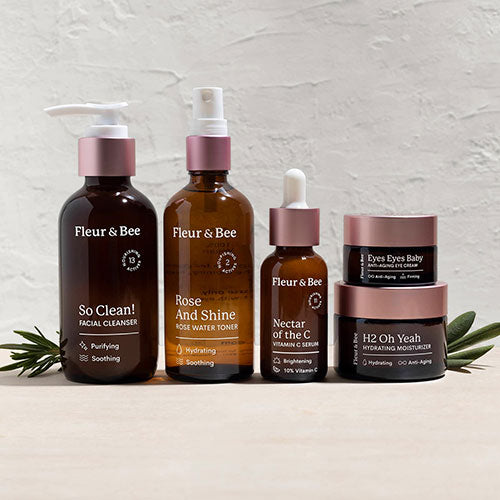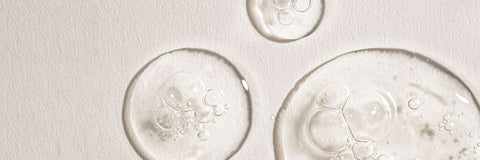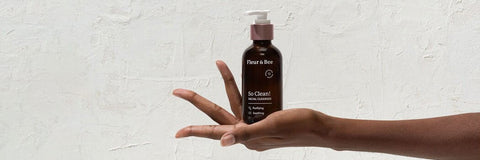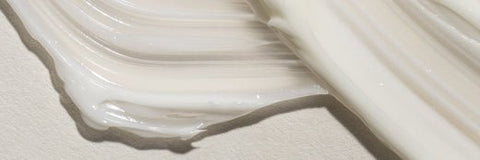With so many different skin care products out there, it can be overwhelming to figure out how to use what and when. A solid skin care routine will help keep your skin glowing and healthy.
Order and timing in your routine are important because doing both correctly will help your products work better and be more effective. We’ve broken down a basic skin care routine order and tips to help you get the most out of your routine.
IN A NUTSHELL
Main Takeaways: In order for your skin care products to work as best they can, it’s important to apply them in the correct order, starting with your cleanser, and then moving from the thinnest product to the thickest.
Good to Know: Serums do not take the place of other products, like a moisturizer. Even if you use a hydrating serum, you should also follow up with a moisturizer.
Recommended Products: Starter Set and Deluxe Set.
1. Cleanser
The first step in any skin care routine is a facial cleanser. It’s incredibly important to cleanse your face every day, especially in the evening. Throughout the day, bacteria, dirt, dead skin, oil, and makeup build up on the surface of your skin. If you don’t wash off the gunk, you risk clogging your pores, and anything else you put on your skin will not be able to do its job. It’s best to cleanse your skin both morning and night.
If you’re a heavy makeup user, you may also want to try what’s known as double cleansing. First, remove your makeup with an oil-based cleanser. The oil bonds with the makeup, lifting it from the surface of your skin. Then, wash your face with a gentle water-based cleanser to fully remove the makeup and oil.
Double cleansing may sound like something people with oily skin should avoid, but that isn’t the case. The oil-based cleanser can also help to remove excess oil by bonding with it as well. Finishing it up with the water-based cleanser will leave your skin feeling fresh and clean, even if you have oily skin.
When washing your face, it’s important to use lukewarm water, rather than hot water. Lukewarm water is gentler on your skin and least likely to irritate it.
2. Exfoliator
An exfoliator is a great addition to any skin care routine; it will help remove dead skin and excess oil. Think of exfoliating as a deep cleaning for your skin.
There are two types of exfoliators: physical and chemical. Physical exfoliators use granules to physically exfoliate your skin. Physical exfoliants can be a little harsh for people with sensitive skin, as the friction can cause irritation. Chemical exfoliants use alpha hydroxy acids, like lactic acid or glycolic acid, or beta hydroxy acids, such as salicylic acid, to help slough off dead skin cells.
Exfoliants should only be used 1-3 times per week, as overuse can cause irritation.
3. Mask
A facial mask is the ultimate at home spa day treatment. There are many types of masks: hydrating, calming, detoxifying, etc. You have many options, so simply use the one that best fits your skin's needs that day. A hydration mask is great if your skin is feeling dry; if you feel like your skin needs an extra deep cleanse, opt for a detox charcoal mask.
Some masks can be used every day; but some masks, like many detox masks, should only be used 1-3 times a week.
4. Toner
This is a step that many people skip or don’t understand, but a good toner helps to prep, hydrate, and balance natural oils.
There are many different kinds of natural toners like rose water, tea tree oil, and witch hazel facial toners. When shopping for a toner, be sure to check for unwanted ingredients, like alcohol. When alcohol is in a toner, it’s usually a high concentration and can potentially dry out your skin.
5. Serum
A serum contains a high concentration of active ingredients that are meant to target a specific concern, such as restoring hydration, reducing dark spots, or improving skin tone/texture.
One common serum is a vitamin C serum, which works to rejuvenate skin, even skin tone, minimize the look of dark spots, and reduce the appearance of wrinkles. When combined with hyaluronic acid and vitamin E, a vitamin C serum is extra effective.
Another common serum is a hyaluronic acid serum. Your body naturally produces hyaluronic acid, and it helps keep your skin hydrated and plump. However, as you age, your body produces less of it. A hyaluronic acid serum will help restore much needed hydration in your skin.
To fight unwanted signs of aging, a retinol serum is your best bet. Retinol is one of the most studied skincare ingredients on the market, and it has been proven to increase cell turnover and encourage collagen production. This means that your skin will become smoother and softer over time, improving the texture of and tone of your skin. However, retinol can be harsh on the skin and cause irritation, so look for a retinol serum that is gentle when first introducing retinol to your routine.
There are many other serums out there, but it’s important to note that a serum is not meant to take the place of a moisturizer, even if it’s a hydrating serum. While generally lightweight and easy to apply, many serums need a few minutes to absorb into your skin before you continue on with the rest of your routine.

6. Eye Cream
An eye cream is something you should start using in your 20s, as it will help prevent the look of dark circles, fine lines, and wrinkles before they begin to form.
Look for an eye cream with a mixture of ingredients that target different concerns. Look for squalane, hyaluronic acid, and glycerin to hydrate skin and diminish the appearance of fine lines and wrinkles. Look for caffeine, green tea, and vitamin E to reduce the look of dark circles and puffiness.
Pro-tip: You can store your eye cream in the fridge. This will help preserve the ingredients, and the cooling sensation will help reduce the look of puffiness as well.
7. Spot Treatment
A spot treatment is used on a blemish and should only be applied to the area of your skin that you’re trying to treat. Dab a small amount on the area before you apply your moisturizer. This will help the product absorb into your skin better and be more effective. Do wait a minute or two for it to absorb, so that you don’t spread it around your face as you add your moisturizer.
8. Face Cream/Moisturizer
It’s very important to moisturize your skin. Using a moisturizer twice a day will help to hydrate your skin and help prevent common signs of aging.
The best botanical ingredients to look for in a moisturizer are aloe, glycerin, jojoba oil, sunflower oil, hyaluronic acid, and squalane. These are all super hydrating ingredients that will leave your skin soft and plump. Some face creams will work to brighten your skin with vitamin C.
Other moisturizers are great for restoring hydration to dry, dehydrated skin.
For your PM routine, you may want to think about using a night cream. A night cream is usually thicker and takes longer to absorb. They also often include ingredients meant to help refresh your skin while you sleep, such as retinol. A good anti-aging night moisturizer might include retinol and plant stem cells to help reduce the appearance of lines, wrinkles and dark spots.
9. Sunscreen
The final step in your AM routine should always be sunscreen. If you use a moisturizer with SPF, then you already have this step covered. If your moisturizer does not include sun protection, we recommend using a facial sunscreen that is rated at SPF 30 or higher.
Sun exposure can dry out your skin and accelerate signs of aging (such as dark spots, fine lines and wrinkles), so it’s important to protect your face, even if it’s cloudy or wintertime.
Now you know the proper skin care routine steps!
At Fleur & Bee we have a handy 5- Step Deluxe Set that includes the most important products for your skin care routine: a cleanser, toner, vitamin C serum, eye cream, and hydrating moisturizer. It’s a convenient way to get the incredible benefits of these skin care essentials in one package.
If you are looking for a very basic routine to begin your skincare journey, there are 3 steps you definitely need to complete every day: cleanse, treat with eye cream, and moisturize. We’ve put these 3 basic skincare items in our Starter Set, saving you both money and the headache of building a routine from scratch.
Using your products in the correct order will allow them to be more effective, leaving your skin looking more healthy, refreshed, and fabulous!
















